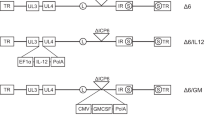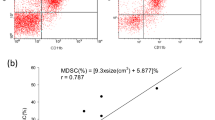Abstract
We evaluated the antitumor effects of combination gene therapy on CT26 mouse colon cancer cells, using the genes for herpes simplex virus thymidine kinase gene HSV-TK combined with granulocyte macrophage colony-stimulating factor (GM-CSF) compared with HSV-TK alone. Cells, unmodified or retrovirally transduced with HSV-TK or GM-CSF, were inoculated subcutaneously into syngeneic BALB/c mice in various combinations. HSV-TK and GM-CSF were also delivered using different routes (in separate cells vs doubly transfected single cells). Both HSV-TK (with i.p. ganciclovir — GCV — treatment) and GM-CSF genes had independent antitumor effects, and given together they caused significant reduction in tumor volumes compared with the HSV-TK gene alone (P<0.001). Following GCV treatment, however, the treated/control ratios for tumor volumes were not different between tumors containing either HSV-TK alone or both genes (0.27 vs 0.25, respectively). Thus, the presence of GM-CSF did not increase the bystander effect of HSV-TK. Tumors receiving genes transferred in separate cells tended to be more consistently suppressed after GCV treatment than when both genes were transferred in the same cells, although this was not statistically significant. Thus, combination GM-CSF and HSV-TK gene therapy produced greater therapeutic efficacy than HSV-TK alone, but the bystander effect was not enhanced by GM-CSF.
This is a preview of subscription content, access via your institution
Access options
Subscribe to this journal
Receive 12 print issues and online access
$259.00 per year
only $21.58 per issue
Buy this article
- Purchase on Springer Link
- Instant access to full article PDF
Prices may be subject to local taxes which are calculated during checkout







Similar content being viewed by others
References
Cho KR, Vogelstein B . Genetic alterations in the adenoma–carcinoma sequence. Cancer. 1992;70 (Suppl):1727–1731.
Herman JR, Adler HL, Aguilar-Cordova E, et al. In situ gene therapy for adenocarcinoma of the prostate: a phase I clinical trial. Hum Gene Ther. 1999;10:1239–1249.
Hasenburg A, Fischer DC, Tong XW, et al. Histologic and immunohistochemical analysis of tissue response to adenovirus-mediated herpes simplex thymidine kinase gene therapy of ovarian cancer. Int J Gynecol Cancer. 2002;12:66–73.
Tan Y, Xu M, Wang W, et al. IL-2 gene therapy of advanced lung cancer patients. Anticancer Res. 1996;16:1993–1998.
Heo DS, Yoon SJ, Kim WS, et al. Locoregional response and increased natural killer activity after intratumoral injection of HLA-B7/beta2-microglobulin gene in patients with cancer. Hum Gene Ther. 1998;9:2031–2038.
Mesnil M, Piccoli C, Tiraby G, Willecke K, Yamasaki H . Bystander killing of cancer cells by herpes simplex virus thymidine kinase gene is mediated by connexins. Proc Natl Acad Sci USA. 1996;93:1831–1835.
Burrows FJ, Gore M, Smiley WR, et al. Purified herpes simplex virus thymidine kinase retroviral particles: III. Characterization of bystander killing mechanisms in transfected tumor cells. Cancer Gene Ther. 2002;9:87–95.
Beck C, Cayeux S, Lupton SD, Dorken B, Blankenstein T . The thymidine kinase/ganciclovir-mediated “suicide” effect is variable in different tumor cells. Hum Gene Ther. 1995;6:1525–1530.
McMasters RA, Saylors RL, Jones KE, Hendrix ME, Moyer MP, Drake RR . Lack of bystander killing in herpes simplex virus thymidine kinase-transduced colon cell lines due to deficient connexin43 gap junction formation. Hum Gene Ther. 1998;9:2253–2261.
Drake RR, Pitlyk K, McMasters RA, Mercer KE, Young H, Moyer MP . Connexin-independent ganciclovir-mediated killing conferred on bystander effect-resistant cell lines by a herpes simplex virus-thymidine kinase-expressing colon cell line. Mol Ther. 2000;2:515–523.
Gagandeep S, Brew R, Green B, et al. Prodrug-activated gene therapy: involvement of an immunological component in the “bystander effect”. Cancer Gene Ther. 1996;3:83–88.
Herrlinger U, Kramm CM, Johnston KM, et al. Vaccination for experimental gliomas using GM-CSF-transduced glioma cells. Cancer Gene Ther. 1997;4:345–352.
Hsieh CL, Pang VF, Chen DS, Hwang LH . Regression of established mouse leukemia by GM-CSF-transduced tumor vaccine: implications for cytotoxic T lymphocyte responses and tumor burdens. Hum Gene Ther. 1997;8:1843–1854.
Kayaga J, Souberbielle BE, Sheikh N, et al. Anti-tumour activity against B16-F10 melanoma with a GM-CSF secreting allogeneic tumour cell vaccine. Gene Ther. 1999;6:1475–1481.
Kruse CA, Roper MD, Kleinschmidt-DeMasters BK, et al. Purified herpes simplex thymidine kinase Retrovector particles. I. In vitro characterization, in situ transduction efficiency, and histopathological analyses of gene therapy-treated brain tumors. Cancer Gene Ther. 1997;4:118–128.
Freeman SM, Abboud CN, Whartenby KA, et al. The bystander effect: tumor regression when a fraction of the tumor mass is genetically modified. Cancer Res. 1993;53:5274–5283.
Rockwell SC, Kallmann RF, Fajardo LF . Characteristics of a serially transplanted mouse mammary tumor and its tissue-culture-adaptive derivative. J Natl Cancer Inst. 1972;49:735–747.
Bonnekoh B, Greenhalgh DA, Chen SH, et al. Ex vivo and in vivo adenovirus-mediated gene therapy strategies induce a systemic anti-tumor immune defence in the B16 melanoma model. J Invest Dermatol. 1998;110:867–871.
Warren P, Song W, Holle E, et al. Combined HSV-TK/GCV and secondary lymphoid tissue chemokine gene therapy inhibits tumor growth and elicits potent antitumor CTL response in tumor-bearing mice. Anticancer Res. 2002;22:599–604.
Janouskova O, Sima P, Kunke D . Combined suicide gene and immunostimulatory gene therapy using AAV-mediated gene transfer to HPV-16 transformed mouse cell: decrease of oncogenicity and induction of protection. Int J Oncol. 2003;22:569–577.
Boucher PD, Ruch RJ, Shewach DS . Differential ganciclovir-mediated cytotoxicity and bystander killing in human colon carcinoma cell lines expressing herpes simplex virus thymidine kinase. Human Gene Ther. 1998;9:801–814.
Caruso M, Panis Y, Gagandeep S, Houssin D, Salzmann JL, Klatzmann D . Regression of established macroscopic liver metastases after in situ transduction of a suicide gene. Proc Natl Acad Sci USA. 1993;90:7024–7028.
Pavlovic J, Nawrath M, Tu R, Heinicke T, Moelling K . Anti-tumor immunity is involved in the thymidine kinase-mediated killing of tumors induced by activated Ki-ras(G12 V). Gene Therapy. 1996;3:635–643.
Armstrong CA, Botella R, Galloway TH, et al. Antitumor effects of granulocyte–macrophage colony-stimulating factor production by melanoma cells. Cancer Res. 1996;56:2191–2198.
Chen SH, Kosai K, Xu B, et al. Combination suicide and cytokine gene therapy for hepatic metastases of colon carcinoma: sustained antitumor immunity prolongs animal survival. Cancer Res. 1996;56:3758–3762.
Yu JS, Burwick JA, Dranoff G, Breakefield XO . Gene therapy for metastatic brain tumors by vaccination with granulocyte-macrophage colony-stimulating factor-transduced tumor cells. Hum Gene Ther. 1997;8:1065–1072.
Whartenby KA, Darnowski JW, Freeman SM, Yurasha K, Calabresi P . Recombinant interferon alpha2a synergistically enhances ganciclovir-mediated tumor cell killing in the herpes simplex virus thymidine kinase system. Cancer Gene Ther. 1999;6:402–408.
Aoki Y, Tani K, Takahashi K, Fukushima M, Ozawa K, Asano S . Regulation of recombinant human granulocyte colony-stimulating factor production using herpes simplex virus 1 thymidine kinase gene. Biochem Biophys Res Commun. 1994;200:1245–1251.
Allen RG, Carey C, Parker JD, Mortrud MT, Mellon SH, Low MJ . Targeted ablation of pituitary pre-proopiomelanocortin cells by herpes simplex virus-1 thymidine kinase differentially regulates mRNAs encoding the adrenocorticotropin receptor and aldosterone synthase in the mouse adrenal gland. Mol Endocrinol. 1995;9:1005–1016.
Acknowledgements
This work has been supported by the Research Center for Bioresource and Health and KOSEF.
Author information
Authors and Affiliations
Corresponding author
Rights and permissions
About this article
Cite this article
Lee, K., Piao, H., Son, B. et al. Herpes simplex virus thymidine kinase and granulocyte macrophage colony-stimulating factor combination gene therapy in a murine CT26 cell colon cancer model. Cancer Gene Ther 11, 570–576 (2004). https://doi.org/10.1038/sj.cgt.7700736
Received:
Published:
Issue Date:
DOI: https://doi.org/10.1038/sj.cgt.7700736
Keywords
This article is cited by
-
Therapeutic properties of a vector carrying the HSV thymidine kinase and GM-CSF genes and delivered as a complex with a cationic copolymer
Journal of Translational Medicine (2015)
-
Recombinant AAV-mediated HSVtk gene transfer with direct intratumoral injections and Tet-On regulation for implanted human breast cancer
BMC Cancer (2006)



